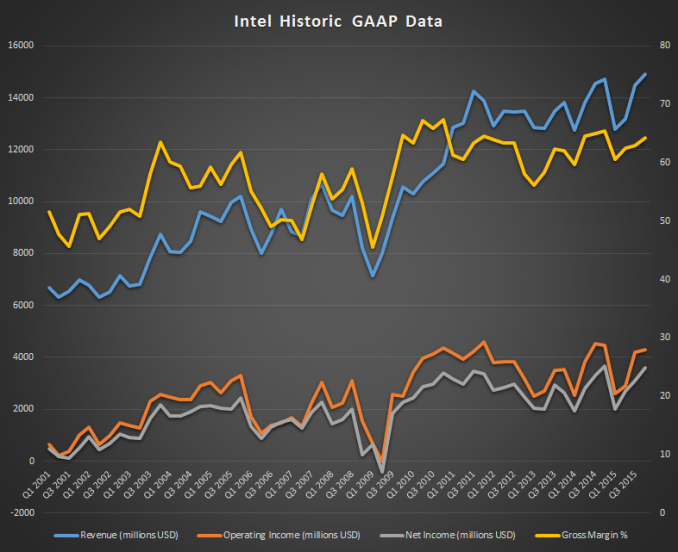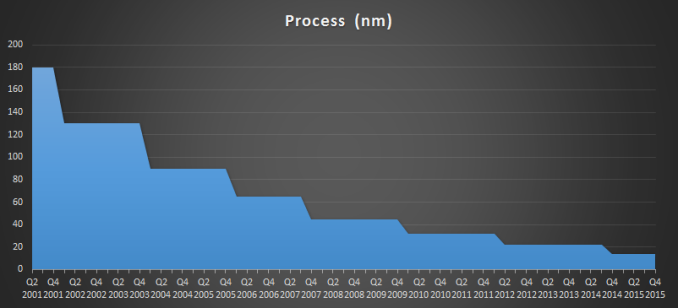Intel Reports Q4 FY 2015 Results: Record Revenue For Q4
by Brett Howse on January 14, 2016 10:00 PM EST- Posted in
- CPUs
- Intel
- Financial Results

Today Intel announced their earnings for the fourth quarter of fiscal year 2015. The year ended strong, with record revenues of $14.9 billion. This is up 1% of Q4 of 2014, and up 3% over last quarter. Intel’s margins did drop a 1.1%, but are still a healthy 64.3% for the quarter. Operating income for the last quarter of the year was $4.3 billion, and net income came in at $3.6 billion. These results are down 3$ and 1% respectively, compared to Q4 of 2014. Earnings per share was flat at $0.74 per share.
For the full fiscal year 2015, revenues were $55.4 billion, which is down 1% compared to 2014. Gross margin was down 1.1% to 62.6% for the year. Operating income was $14.0 billion, down 9% compared to 2014, and net income was down 2% to $11.4 billion.
| Intel Q4 2015 Financial Results (GAAP) | |||||
| Q4'2015 | Q3'2015 | Q4'2014 | |||
| Revenue | $14.9B | $14.5B | $14.7B | ||
| Operating Income | $4.3B | $4.2B | $4.4B | ||
| Net Income | $3.6B | $3.1B | $3.6B | ||
| Gross Margin | 64.3% | 63.0% | 65.4% | ||
| Client Computing Group Revenue | $8.8B | +3% | -1% | ||
| Data Center Group Revenue | $4.3B | +4% | +5% | ||
| Internet of Things Revenue | $625M | +8% | +6% | ||
| Software and Services Revenue | $543M | -2% | -3% | ||
| All Other Revenue | $682M | flat | +11% | ||
For the full year, Intel’s largest division, the Client Computing Group, was down 8% in revenue to $32.2 billion, but for Q4 2015 the group was down just 1% year-over-year. Intel is currently shipping 14 nm parts based on Skylake, and as of November, 14 nm parts made up over 50% of the Client Computing Group’s unit sales. The move to 14 nm has been pretty slow by Intel’s standards, and even many of the Skylake chips are in short supply still, but Intel did say that yields have improved to the point where they feel they have an oversupply at the moment so hopefully some of the high demand parts find their way to retailers for stock. With the drop in the overall PC market, it’s not too surprising that this group has dropped, but although total device numbers have dropped, average selling price has increased.
Intel’s record revenue came from the Data Center group, which had record revenue for FY 2015 of $16.0 billion, up 11% compared to 2014. For the quarter, Data Center revenue grew 5% year-over-year to $4.3 billion. The move to cloud computing is going to drive some growth here, and offset some of the weakness in the PC market for companies like Intel. Margins are generally better in this group, so it is less difficult to offset the PC drop with a high margin area like Data Center. Intel is pretty much unchallenged in this space for a lot of computing needs, at least at the moment. There was some struggle in China's market, but the overall market was enough to overcome this.
Internet of Things also had record revenue for the fiscal year. For FY 2015, this segment’s revenue was up 7% to $2.3 billion. It’s still pretty small potatoes compared to the other segments of Intel, but this is one area where they are keen to not fall behind ARM like they did in the mobile space. There is a lot of room for growth here, although it’s going to be at a much lower margin than Intel is accustomed to. For Q4, this division grew 6% year-over-year to $625 million.
Software and Services, which consists of products like McAfee Antivirus, was down 2% for the full year to $2.2 billion. For Q4, revenues were down 3% compared to Q4 2014, coming in at $543 million.
The final segment is Non-Volatile Memory Solutions, and for 2015 this segment had record full-year revenue, up 21% compared to 2014. Unfortunately, Intel does not break this out individually, but it on the conference call they announced revenues of $2.6 billion for FY 2015. Intel announced their 3D X-Point memory, and shipments should start later this year.
For the full year, Intel paid $7.6 billion back to shareholders, with $4.6 billion in dividends and $3.0 billion used to repurchase stock. Intel has announced an increase in dividends to $1.04-per-share on an annual basis.
Intel also announced that they have completed the acquisition of Altera and they took on about $9.5 billion in debt to finance this.
Looking towards FY 2016, Intel is expecting mid to high single digit revenue growth as a percentage compared to 2015, which is an increase over their guidance issued in November. This increase is being attributed to the FPGA business which they have just acquired through Altera. Gross margin is expected to be 63%.
Source: Intel Investor Relations












20 Comments
View All Comments
guidryp - Friday, January 15, 2016 - link
You can't blame Intel for being hemmed in by physics/software. All the low hanging CPU fruit has been plucked years ago. We are in the age of diminishing returns.If Intel was doing such a bad job, AMD would have caught up to them years ago. Don't count on Zen to leapfrog Intel, AMD faces the same constraints as Intel.
Back when CPU performance was making big jumps, it was largely driven by clockspeed and core count increases. But we hit the wall on clockspeed more than a decade ago and software has us at the wall for core count(except in specialized niches) as well.
PC sales have declined because they have been "good enough" for a decade or more, and making them faster is pretty much irrelevant to the masses, who have their attention elsewhere (Smartphones).
bill.rookard - Friday, January 15, 2016 - link
I don't think Zen will help AMD leapfrog Intel, but it should erase some of the performance disparity. Here's hoping.guidryp - Friday, January 15, 2016 - link
I hope so to. For AMD's sake, not because I think it will drive Intel to suddenly release a bunch of performance gains they were sitting on.AMD's position is kind of precarious being in second place in both GPU and CPU and getting more distant second as time goes by.
AMD needs to get closer to parity if there is going to be an AMD much longer.
name99 - Friday, January 15, 2016 - link
What you CAN blame Intel for is fantasizing that x86 was, "OMG, so awesome it's the only platform anyone will ever use for anything"."Computing" is not in a slump --- last time I checked massive numbers of phones are being sold, watches are about to take off, cars have a huge future, health and home are about to come online. But Intel is barely part of any of this, because the millstone called x86-comptibility held (and continue to hold) them back. By the time they got Atom to anything interesting, ARM was there with A57 and A72. By the time they got Core-m anywhere interesting, Apple had showed that an ARM ISA could achiever comparable performance at lower frequency and higher performance/W.
And they still don't learn, shipping this garbage called Quark under some delusion that that is going to power our future dashcams and weather stations.
The only thing keeping Intel going right now is eating their seed corn. They can continue to squeeze some money out of servers for two or three years (I expect ARM servers to be truly competitive starting around 2017, last year's and this year's models remain the experimental learning models); but while Intel can try to compete by dropping the price of Xeon-D, the main thing that does is remove the revenue that Intel is built upon. Intel cannot survive on the margins provided by a world of Atoms at A57 prices and Xeon-D at "16xA72 on a SoC" prices.
SO we see Intel return to where it came from, a memory company?
Michael Bay - Sunday, January 17, 2016 - link
>ARM servers>truly competitive
Nice joke. They don`t even compete in pure storage yet, not even mentioning computation.
>watches are about to take off
>health and home are about to come online
Ah, so you`re just drunk.
jasonelmore - Sunday, January 17, 2016 - link
intel's manufacturing process is their ace of spades. If they ever got in bad shape, they could open up a niche fab, that has high margins and makes the absolute lowest power parts for any company who needs them.You under-estimate intel. If you knew just how many smart engineers they have, you wouldn't dare doubt their capabilities. Sure their marketing and sales teams make mistakes, but the core of their business has a bright future.
They have had a 4 year lead on fin fet manufacturing. Right now, they are working on technologies beyond fin fet, while competitors are trying to nail down fin fet so they can make big dies for GPU's
digiguy - Sunday, January 17, 2016 - link
Excellent reply, CPU are good enough even for gaming. And for gaming what matters is GPU above all and GPUs have been making leaps forward. Apart from the gaming market the enthusiast market is too small to even care about. And even geeks like me and many that read this site are not looking for the 18 cores CPU, but for things like a laptop that is powerful enough to work on the go but with long battery life for when you are not home. Or a powerful convertible that is also silent. Core M is the response to ARM chips, Skylake Core M has largely improved over the original Broadwell. We have seen it over the last few months and at CES, most manufacturers are embracing Core M. Intel is catching up on this, but is on the right track.just4U - Tuesday, January 19, 2016 - link
I'd say good enough since the Core2... Even today while the older 6X class is finally starting to struggle you can still get some nice usage out of the 8x dualcores and Quads.jasonelmore - Friday, January 15, 2016 - link
You know AMD's future is bad when people recommend that AMD Build a FAST CPU just so they can buy a intel one cheaper, with more features.eanazag - Friday, January 15, 2016 - link
I think you missed a very important detail over the last few years. ARM. Intel was not power competitive and that was the goal for the last few generations - maintain performance while improving efficiency. The majority of consumers dictated this along with no competitive pressure from AMD.